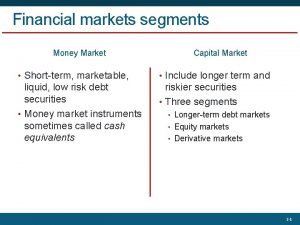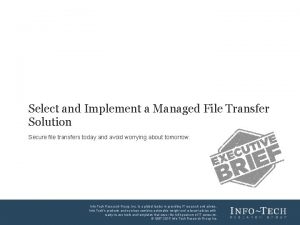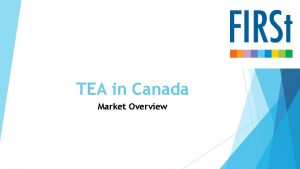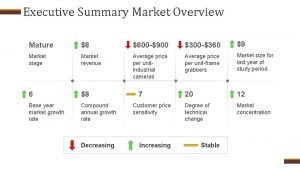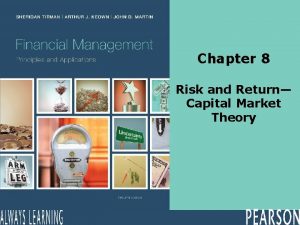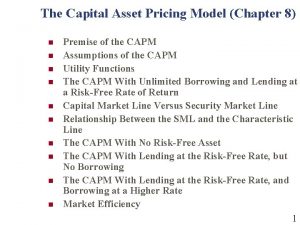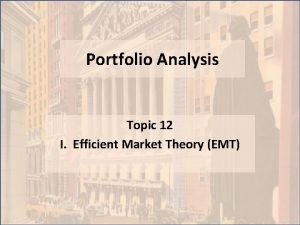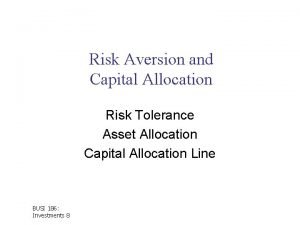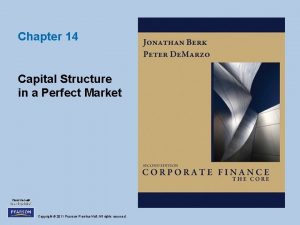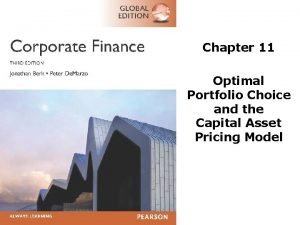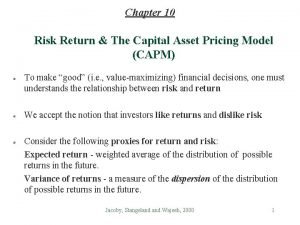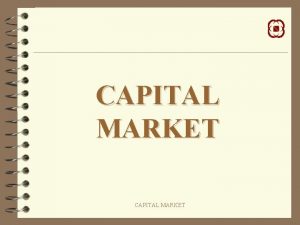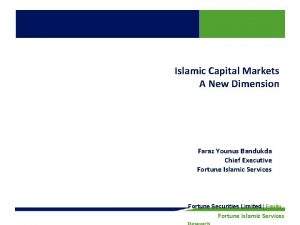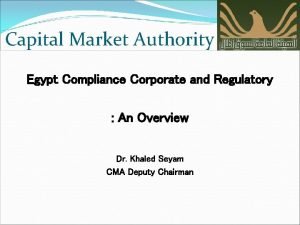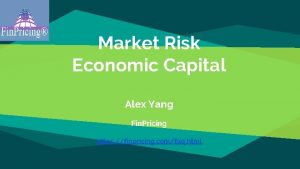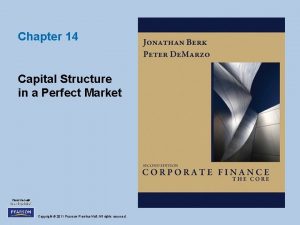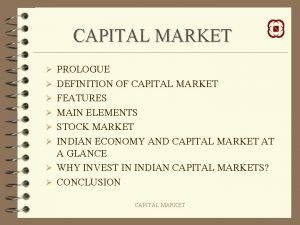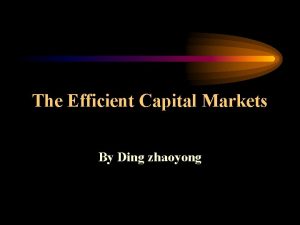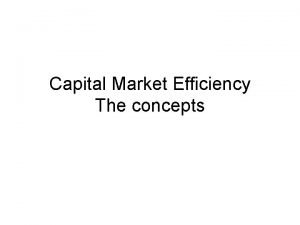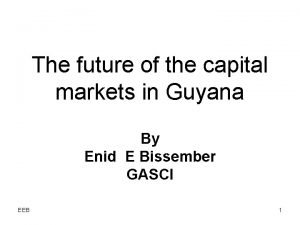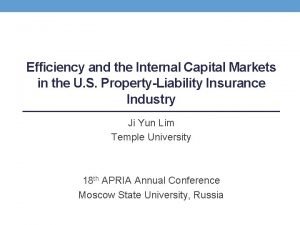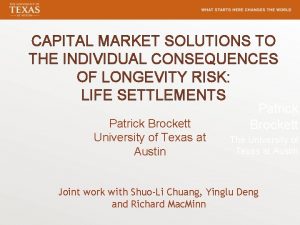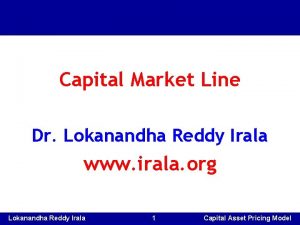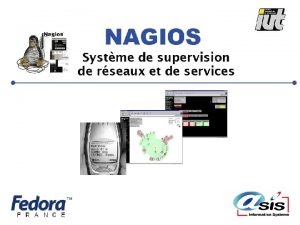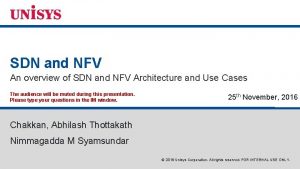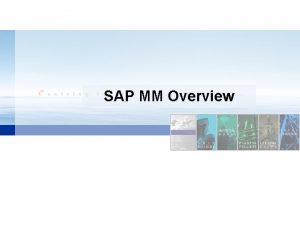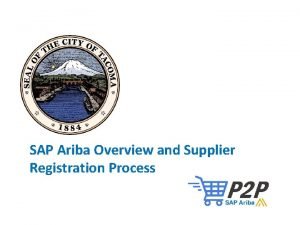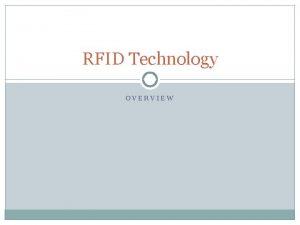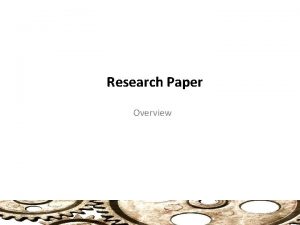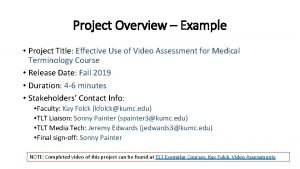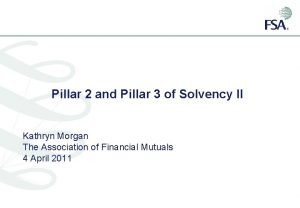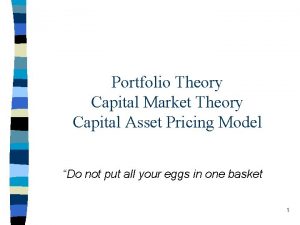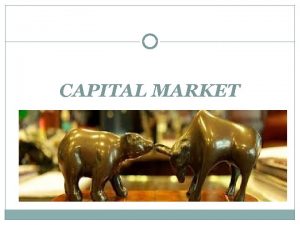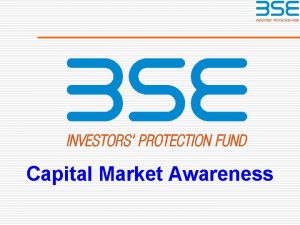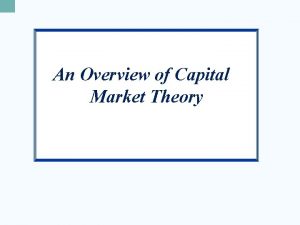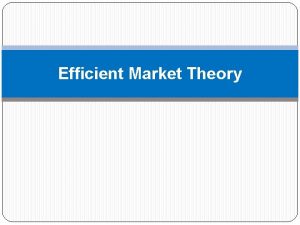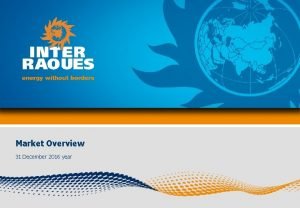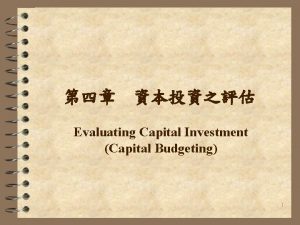Capital Market Theory An Overview Capital market theory
































































- Slides: 64


Capital Market Theory: An Overview • Capital market theory extends portfolio theory and develops a model for pricing all risky assets • Capital asset pricing model (CAPM) will allow you to determine the required rate of return for any risky asset

Assumptions of Capital Market Theory 1. All investors are Markowitz efficient investors who want to target points on the efficient frontier. – The exact location on the efficient frontier and, therefore, the specific portfolio selected, will depend on the individual investor’s risk-return utility function. • Markowitz efficient investor

Assumptions of Capital Market Theory 2. Investors can borrow or lend any amount of money at the risk-free rate of return (RFR). – Clearly it is always possible to lend money at the nominal risk-free rate by buying risk-free securities such as government T-bills. It is not always possible to borrow at this risk-free rate, but we will see that assuming a higher borrowing rate does not change the general results.

Assumptions of Capital Market Theory 3. All investors have homogeneous expectations; that is, they estimate identical probability distributions for future rates of return. – Again, this assumption can be relaxed. As long as the differences in expectations are not vast, their effects are minor.

Assumptions of Capital Market Theory 4. All investors have the same one-period time horizon such as one-month, six months, or one year. – The model will be developed for a single hypothetical period, and its results could be affected by a different assumption. A difference in the time horizon would require investors to derive risk measures and risk-free assets that are consistent with their time horizons.

Assumptions of Capital Market Theory 5. All investments are infinitely divisible, which means that it is possible to buy or sell fractional shares of any asset or portfolio. – This assumption allows us to discuss investment alternatives as continuous curves. Changing it would have little impact on theory.

Assumptions of Capital Market Theory 6. There are no taxes or transaction costs involved in buying or selling assets. – This is a reasonable assumption in many instances. Neither pension funds nor religious groups have to pay taxes, and the transaction costs for most financial institutions are less than 1 percent on most financial instruments. Again, relaxing this assumption modifies the results, but does not change the basic thrust.

Assumptions of Capital Market Theory 7. There is no inflation or any change in interest rates, or inflation is fully anticipated. – This is a reasonable initial assumption, and it can be modified.

Assumptions of Capital Market Theory 8. Capital markets are in equilibrium. – This means that we begin with all investments properly priced in line with their risk levels.

Assumptions of Capital Market Theory • Some of these assumptions are unrealistic • Relaxing many of these assumptions would have only minor influence on the model and would not change its main implications or conclusions. • A theory should be judged on how well it explains and helps predict behavior, not on its assumptions.

Risk-Free Asset • • An asset with zero standard deviation Zero correlation with all other risky assets Provides the risk-free rate of return (RFR) Will lie on the vertical axis of a portfolio graph

Risk-Free Asset Covariance between two sets of returns is Because the returns for the risk free asset are certain, Thus Ri = E(Ri), and Ri - E(Ri) = 0 Consequently, the covariance of the risk-free asset with any risky asset or portfolio will always equal zero. Similarly the correlation between any risky asset and the risk-free asset would be zero.

Combining a Risk-Free Asset with a Risky Portfolio Expected return the weighted average of the two returns This is a linear relationship

Combining a Risk-Free Asset with a Risky Portfolio Standard deviation The expected variance for a two-asset portfolio is Substituting the risk-free asset for Security 1, and the risky asset for Security 2, this formula would become Since we know that the variance of the risk-free asset is zero and the correlation between the risk-free asset and any risky asset i is zero we can adjust the formula

Combining a Risk-Free Asset with a Risky Portfolio Given the variance formula the standard deviation is Therefore, the standard deviation of a portfolio that combines the risk-free asset with risky assets is the linear proportion of the standard deviation of the risky asset portfolio.

Combining a Risk-Free Asset with a Risky Portfolio Since both the expected return and the standard deviation of return for such a portfolio are linear combinations, a graph of possible portfolio returns and risks looks like a straight line between the two assets.

Portfolio Possibilities Combining the Risk-Free Asset and Risky Portfolios on the Efficient Frontier Exhibit 8. 1 M C RFR A B D

Risk-Return Possibilities with Leverage To attain a higher expected return than is available at point M (in exchange for accepting higher risk) • Either invest along the efficient frontier beyond point M, such as point D • Or, add leverage to the portfolio by borrowing money at the risk-free rate and investing in the risky portfolio at point M

Portfolio Possibilities Combining the Risk-Free Asset and Risky Portfolios on the Efficient Frontier rr o B g n i nd Le RFR M o g n i w L M C Exhibit 8. 2

The Market Portfolio • Because portfolio M lies at the point of tangency, it has the highest portfolio possibility line • Everybody will want to invest in Portfolio M and borrow or lend to be somewhere on the CML • Therefore this portfolio must include ALL RISKY ASSETS

The Market Portfolio Because the market is in equilibrium, all assets are included in this portfolio in proportion to their market value

The Market Portfolio Because it contains all risky assets, it is a completely diversified portfolio, which means that all the unique risk of individual assets (unsystematic risk) is diversified away

Systematic Risk • Only systematic risk remains in the market portfolio • Systematic risk is the variability in all risky assets caused by macroeconomic variables • Systematic risk can be measured by the standard deviation of returns of the market portfolio and can change over time

Examples of Macroeconomic Factors Affecting Systematic Risk • Variability in growth of money supply • Interest rate volatility • Variability in – industrial production – corporate earnings – cash flow

How to Measure Diversification • All portfolios on the CML are perfectly positively correlated with each other and with the completely diversified market Portfolio M • A completely diversified portfolio would have a correlation with the market portfolio of +1. 00

Diversification and the Elimination of Unsystematic Risk • The purpose of diversification is to reduce the standard deviation of the total portfolio • This assumes that imperfect correlations exist among securities • As you add securities, you expect the average covariance for the portfolio to decline • How many securities must you add to obtain a completely diversified portfolio?

Diversification and the Elimination of Unsystematic Risk Observe what happens as you increase the sample size of the portfolio by adding securities that have some positive correlation

Number of Stocks in a Portfolio and the Standard Deviation of Portfolio Return Standard Deviation of Return Exhibit 8. 3 Unsystematic (diversifiable) Risk Total Risk Systematic Risk Standard Deviation of the Market Portfolio (systematic risk) Number of Stocks in the Portfolio

The CML and the Separation Theorem • The CML leads all investors to invest in the M portfolio • Individual investors should differ in position on the CML depending on risk preferences • How an investor gets to a point on the CML is based on financing decisions • Risk averse investors will lend part of the portfolio at the risk-free rate and invest the remainder in the market portfolio

The CML and the Separation Theorem Investors preferring more risk might borrow funds at the RFR and invest everything in the market portfolio

The CML and the Separation Theorem The decision of both investors is to invest in portfolio M along the CML (the investment decision)

The CML and the Separation Theorem The decision to borrow or lend to obtain a point on the CML is a separate decision based on risk preferences (financing decision)

The CML and the Separation Theorem Tobin refers to this separation of the investment decision from the financing decision, the separation theorem

A Risk Measure for the CML • Covariance with the M portfolio is the systematic risk of an asset • The Markowitz portfolio model considers the average covariance with all other assets in the portfolio • The only relevant portfolio is the M portfolio

A Risk Measure for the CML Together, this means the only important consideration is the asset’s covariance with the market portfolio

A Risk Measure for the CML Because all individual risky assets are part of the M portfolio, an asset’s rate of return in relation to the return for the M portfolio may be described using the following linear model: where: Rit = return for asset i during period t ai = constant term for asset i bi = slope coefficient for asset i RMt = return for the M portfolio during period t = random error term

Variance of Returns for a Risky Asset

The Capital Asset Pricing Model: Expected Return and Risk • The existence of a risk-free asset resulted in deriving a capital market line (CML) that became the relevant frontier • An asset’s covariance with the market portfolio is the relevant risk measure • This can be used to determine an appropriate expected rate of return on a risky asset - the capital asset pricing model (CAPM)

• The Capital Asset Pricing Model: Expected Return and Risk CAPM indicates what should be the expected or required rates of return on risky assets • This helps to value an asset by providing an appropriate discount rate to use in dividend valuation models • You can compare an estimated rate of return to the required rate of return implied by CAPM - over/under valued ?

The Security Market Line (SML) • The relevant risk measure for an individual risky asset is its covariance with the market portfolio (Covi, m) • This is shown as the risk measure • The return for the market portfolio should be consistent with its own risk, which is the covariance of the market with itself - or its variance:

Graph of Security Market Exhibit Line 8. 5 (SML) SML RFR

The Security Market Line (SML) The equation for the risk-return line is We then define as beta

Graph of SML with Exhibit 8. 6 Normalized Systematic Risk SML Negative Beta RFR

Determining the Expected Rate of Return for a Risky Asset • The expected rate of return of a risk asset is determined by the RFR plus a risk premium for the individual asset • The risk premium is determined by the systematic risk of the asset (beta) and the prevailing market risk premium (RM-RFR)

Determining the Expected Rate of Return for a Risky Asset Assume: RFR = 6% (0. 06) RM = 12% (0. 12) Implied market risk premium = 6% (0. 06) E(RA) = 0. 06 + 0. 70 (0. 12 -0. 06) = 0. 102 = 10. 2% E(RB) = 0. 06 + 1. 00 (0. 12 -0. 06) = 0. 120 = 12. 0% E(RC) = 0. 06 + 1. 15 (0. 12 -0. 06) = 0. 129 = 12. 9% E(RD) = 0. 06 + 1. 40 (0. 12 -0. 06) = 0. 144 = 14. 4% E(RE) = 0. 06 + -0. 30 (0. 12 -0. 06) = 0. 042 = 4. 2%

Determining the Expected Rate of Return for a Risky • In equilibrium, Asset all assets and all portfolios of assets should plot on the SML • Any security with an estimated return that plots above the SML is underpriced • Any security with an estimated return that plots below the SML is overpriced • A superior investor must derive value estimates for assets that are consistently superior to the consensus market evaluation to earn better risk -adjusted rates of return than the average investor

Identifying Undervalued and Overvalued Assets • Compare the required rate of return to the expected rate of return for a specific risky asset using the SML over a specific investment horizon to determine if it is an appropriate investment • Independent estimates of return for the securities provide price and dividend outlooks

Price, Dividend, and Rate of Return Estimates Exhibit 8. 7

Comparison of Required Rate of Return to Estimated Rate of Return Exhibit 8. 8

Plot of Estimated Returns on SML Graph Exhibit 8. 9 E -. 40 -. 20 . 22. 20. 18. 16. 14. 12 Rm. 10. 08. 06. 04. 02 C SML A B D. 20 . 40 . 60 . 80 1. 20 1. 40 1. 60 1. 80

Calculating Systematic Risk: The Characteristic Line The systematic risk input of an individual asset is derived from a regression model, referred to as the asset’s characteristic line with the model portfolio: where: Ri, t = the rate of return for asset i during period t RM, t = the rate of return for the market portfolio M during t

Scatter Plot of Rates of Return The characteristic Ri line is the regression line of the best fit through a scatter plot of rates of return Exhibit 8. 10 RM

The Impact of the Time Interval • Number of observations and time interval used in regression vary • Value Line Investment Services (VL) uses weekly rates of return over five years • Merrill Lynch, Pierce, Fenner & Smith (ML) uses monthly return over five years • There is no “correct” interval for analysis • Weak relationship between VL & ML betas due to difference in intervals used • The return time interval makes a difference, and its impact increases as the firm’s size declines

The Effect of the Market Proxy • The market portfolio of all risky assets must be represented in computing an asset’s characteristic line • Standard & Poor’s 500 Composite Index is most often used – Large proportion of the total market value of U. S. stocks – Value weighted series

Weaknesses of Using S&P 500 as the Market Proxy – Includes only U. S. stocks – The theoretical market portfolio should include U. S. and non-U. S. stocks and bonds, real estate, coins, stamps, art, antiques, and any other marketable risky asset from around the world

Empirical Tests of the CAPM • Stability of Beta – betas for individual stocks are not stable, but portfolio betas are reasonably stable. Further, the larger the portfolio of stocks and longer the period, the more stable the beta of the portfolio • Comparability of Published Estimates of Beta – differences exist. Hence, consider the return interval used and the firm’s relative size

What is Next? • Alternative asset pricing models

Summary • The dominant line is tangent to the efficient frontier – Referred to as the capital market line (CML) – All investors should target points along this line depending on their risk preferences

Summary • All investors want to invest in the risky portfolio, so this market portfolio must contain all risky assets – The investment decision and financing decision can be separated – Everyone wants to invest in the market portfolio – Investors finance based on risk preferences

Summary • The relevant risk measure for an individual risky asset is its systematic risk or covariance with the market portfolio – Once you have determined this Beta measure and a security market line, you can determine the required return on a security based on its systematic risk

Summary • Assuming security markets are not always completely efficient, you can identify undervalued and overvalued securities by comparing your estimate of the rate of return on an investment to its required rate of return

Summary • When we relax several of the major assumptions of the CAPM, the required modifications are relatively minor and do not change the overall concept of the model.

Summary • Betas of individual stocks are not stable while portfolio betas are stable • There is a controversy about the relationship between beta and rate of return on stocks • Changing the proxy for the market portfolio results in significant differences in betas, SMLs, and expected returns
 Capital allocation line vs capital market line
Capital allocation line vs capital market line Financial market segments
Financial market segments Money market conclusion
Money market conclusion Market overview managed file transfer solutions
Market overview managed file transfer solutions Forrester real time interaction management
Forrester real time interaction management Tea consumption in canada
Tea consumption in canada Market overview slide
Market overview slide Market risk
Market risk Assumption of capm model
Assumption of capm model Capital market theory
Capital market theory Leader challenger
Leader challenger Objectives of segmentation
Objectives of segmentation Introduction of working capital
Introduction of working capital Source of capital reserve
Source of capital reserve Multinational cost of capital and capital structure
Multinational cost of capital and capital structure Difference between capital reserve and reserve capital
Difference between capital reserve and reserve capital Basle ii
Basle ii Regulatory capital vs economic capital
Regulatory capital vs economic capital Constant and variable capital
Constant and variable capital Multinational cost of capital and capital structure
Multinational cost of capital and capital structure Dominant capital allocation line
Dominant capital allocation line Capital structure in a perfect market
Capital structure in a perfect market Arhousr
Arhousr Capital market line
Capital market line Capital market structure in india
Capital market structure in india Azleema
Azleema Importance of capital market
Importance of capital market The following are advantages of the sml approach
The following are advantages of the sml approach Capital market authority egypt
Capital market authority egypt Market risk economic capital
Market risk economic capital Chapter 14 capital structure in a perfect market
Chapter 14 capital structure in a perfect market Conclusion of capital market
Conclusion of capital market An efficient capital market is one in which
An efficient capital market is one in which What is market efficiency
What is market efficiency Functions of capital market
Functions of capital market Internal capital market definition
Internal capital market definition Capital market solutions definition
Capital market solutions definition Cml equation
Cml equation Informationally efficient
Informationally efficient Www stands for world wide web
Www stands for world wide web Maximo work order priority
Maximo work order priority Universal modeling language
Universal modeling language In uml is a connection among things
In uml is a connection among things Vertical retailers
Vertical retailers Figure 12-1 provides an overview of the lymphatic vessels
Figure 12-1 provides an overview of the lymphatic vessels Pulmonary circuit
Pulmonary circuit Texas public school finance overview
Texas public school finance overview Walmart
Walmart Stylistic overview
Stylistic overview Difference between sa/sd and jsd
Difference between sa/sd and jsd Spring framework overview
Spring framework overview Nagios tactical overview
Nagios tactical overview Nfv vs sdn
Nfv vs sdn Sbic program overview
Sbic program overview Sap mm overview
Sap mm overview Ariba registration process
Ariba registration process Safe overview
Safe overview Rfid technology overview
Rfid technology overview Review paper introduction
Review paper introduction Perbedaan replikasi virus dna dan rna
Perbedaan replikasi virus dna dan rna Title of project example
Title of project example Venous drainage of the abdomen
Venous drainage of the abdomen Abstract overview
Abstract overview Solvency ii pillar 3
Solvency ii pillar 3 Which of the following is a physical storage media
Which of the following is a physical storage media

